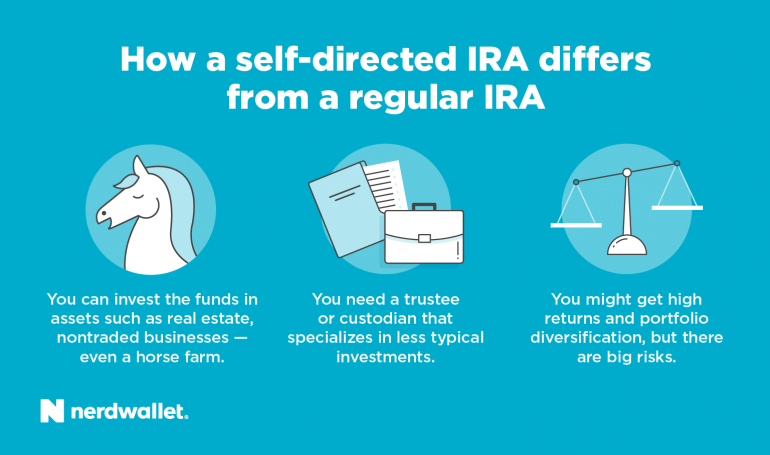Self-Directed IRA (SDIRA): How It Works and Where to Open One
This type of IRA allows you to hold alternative investments in a retirement account, but it comes with complex rules and risks.
Many, or all, of the products featured on this page are from our advertising partners who compensate us when you take certain actions on our website or click to take an action on their website. However, this does not influence our evaluations. Our opinions are our own. Here is a list of our partners and here's how we make money.
The investing information provided on this page is for educational purposes only. NerdWallet, Inc. does not offer advisory or brokerage services, nor does it recommend or advise investors to buy or sell particular stocks, securities or other investments.
What is a self-directed IRA?
A self-directed IRA (SDIRA) is a type of IRA that holds alternative investments not typically found in conventional IRAs. In addition to bonds, stocks, and mutual funds, SDIRA investment options could include real estate, precious metals, cryptocurrency and more.
SDIRAs are bound by the usual IRA rules, including annual IRA contribution limits and withdrawal rules. They also come in two forms: the traditional IRA, which takes tax-deductible contributions, or the Roth IRA, which allows tax-free distributions in retirement.
A SDIRA is considered “self-directed” because although a custodian or trustee administers the account, it’s the account holder who directly manages the investments and assumes all risk.
» More on choosing between a traditional or Roth IRA
Self-directed IRA rules
Although self-directed IRAs offer more flexibility in investment selection than traditional or Roth IRAs, the are also a significant number of rules that govern them. This includes the “no self-dealing” rule, which prohibits you from borrowing money from your IRA, selling property to it, and other interactions.
Another SDIRA rule prohibits entering into deals with specific relatives, including parents and children. See Publication 560 for more details.
How to open a self-directed IRA
To open a self-directed IRA, the IRS requires you to go through a custodian who will hold the account. Custodians of SDIRAs are often financial institutions or trust companies, and their role is to ensure the account owners follow IRA rules, such as the annual contribution limit and reporting to the IRS.
When selecting a custodian for your SDIRA, some things to consider include whether they’re approved by the IRS, fee structure and the types of investments they handle.
After choosing your custodian, you can open your account and fund it like any IRA. Custodians won’t offer financial guidance or investing advice, so you’ll be on your own when it comes to due diligence and selecting investments.
» Want investing help instead? View our picks for best online financial advisors
Best self-directed IRAs
There are a lot of self-directed IRAs out there, so we compared them to help you find the best option for yourself. We looked at factors including an account's minimum balance, available investments, fees you would have to pay your first year holding the account, customer service hours and audit protection from the IRS.
In terms of available investments, some accounts allow you to invest in anything permissible by the IRS, which includes just about everything from real estate to commodities to startups. Other self-directed IRAs restrict your options further.
Most self-directed IRAs have much higher fees than their non-self-directed counterparts. But if you have your heart set on a self-directed IRA, you should be prepared, at a minimum, to pay a set-up fee and an annual fee. To score these self-directed IRAs on their fees we calculated what you would have to pay just in your first year — but keep in mind that you would likely have to pay some fees on an ongoing basis.
» Want lower fees? Check out the best Roth IRAs
Standout feature: Audit protection 🎉
No account minimum
Audit protection
No restricted investments
High first-year fee
IRA Financial is one of the only self-directed IRAs we reviewed that offers free audit protection, meaning if your IRA is audited by the IRS, IRA Financial will help you through the process for no extra cost.
IRA Financial scores well in every category, plus they offer prohibited transaction reviews (to help you understand what you can't invest in), investment guidance and educational resources through podcasts, blog posts and videos.
IRA Financial's first-year fee is relatively high among this group, at $495.
Standout feature: Lowest fees 🤑
No account minimum
Low first-year fee
No audit protection
The Entrust Group has the lowest fees out of every self-directed IRA we reviewed, with a first-year fee of only $249, but they don't offer audit protection, and they have slightly worse customer service options. They also have several educational resources and are audited by external CPA firms.
But if fees are the most important factor for you, The Entrust Group may be your best bet among these SDIRAs.
Standout feature: Advisor access 👩💼
No account minimum
Access to advisors for financial, legal or tax advice
High first-year fees
Restricted investments
No audit protection
Directed IRA's offering may not be right for everyone due to its higher fees (its first-year fee is among the highest at $595), but if you want access to financial advisors, lawyers or tax professionals, they can help with that. Directed IRA also has annual audits by outside CPA firms.
Directed IRA also restricts some investments, such as cannabis-based investments.
Compare more self-directed IRAs
Here's a list of all the self-directed IRAs we reviewed, including their minimum balances, first-year fees and available investments. All of the following self-directed IRAs also have a checkbook control IRA options, meaning IRAs that you can write checks from.
Minimum balance | First-year fees | Available investments | |
|---|---|---|---|
IRA Financial | $0 | $495 | Any |
The Entrust Group | $0 | $249 | Any |
Directed IRA | $0 | $595 | Restricted |
uDirect IRA | $325 | $325 | Any |
Rocket Dollar | $0 | $720 | Any |
Madison Trust Company | $500 | $490 | Restricted |
Advantages of a self-directed IRA
For well-experienced investors, SDIRAs offer three distinct advantages:
Diversification. Investors can build a portfolio of investments to their specifications, investing in things that aren't typically offered in conventional retirement accounts.
Potential for higher returns. For an investor well-versed in a specific industry or asset type, investing in a SDIRA could allow them to take advantage of those potential returns in a retirement account.
Tax breaks. In a SDIRA, investors can choose their investments and build a portfolio to their specifications while still receiving the tax breaks found in traditional or Roth IRAs.

Risks of self-directed IRAs
The potential benefits are well and good — but it’s also important to consider the substantial risks:
Self-directed due diligence. In a SDIRA, custodians and trustees only manage the account. They provide no financial guidance or recommendations. Instead, it’s up to the account holder to do their own due diligence, including evaluating future revenue and expenses for their investments, verifying the accuracy of financial information and more.
Fees. SDIRA fees vary by custodian and type of investment and are also dependent on actions taken by the account holder.
Lack of liquidity. Self-directed IRAs allow you to invest in a wide variety of investments, but those assets are often illiquid, meaning that if you run into an unexpected emergency, you might be hard-pressed to get money out of your IRA. You’ll need to find a buyer for the investment. This can also be an issue for owners of traditional self-directed IRAs when required minimum distributions come due at age 73.
Lack of transparency. It can be hard to determine the monetary worth of an investment, particularly when buying and selling. The Securities and Exchange Commission (SEC) warns investors that self-directed IRA promoters sometimes list the purchase price, or the purchase price plus expected returns, as the valuation. But that figure isn't the actual amount you'll get for the asset. "If possible, take steps to independently verify information — such as prices and asset values — provided in account statements," the agency says.
Higher potential for fraud. Fraudsters have used self-directed IRAs as a way to add a stamp of legitimacy to their schemes. One common ruse is to say the IRA custodian has vetted or approved of the underlying investment, when, as the SEC notes, custodians generally don’t evaluate “the quality or legitimacy of any investment in the self-directed IRA or its promoters.”
Concentrated portfolios. Proponents of self-directed IRAs say their ability to invest outside the mainstream improves their diversification, but a self-directed IRA can lack diversity just as easily as any other retirement account.

on Capitalize's website
The bottom line
Self-directed IRAs offer more variety in investment options while still providing the tax benefits of an IRA. However, because account holders select and manage investments on their own, SDIRAs are ideal for experienced investors who have the financial experience and knowledge necessary to take on the risk.
For most other retirement savers, the range of assets available through a traditional IRA — stocks, bonds, CDs, ETFs, mutual funds and REITs (that is, real estate investment trusts) — provide more than enough investment diversity.
Traditional IRAs can also be quick and relatively easy to open, provide the same tax benefits as a self-directed IRA without exposure to all the extra IRS rules, and are more readily available at various financial institutions.
» Check out our list of top picks for best IRA accounts.
Table of Contents
Table of Contents




